5 Easy Facts About Kensun Hid Reviews Explained
Table of ContentsKensun Hid Reviews - An Overview7 Easy Facts About Kensun Hid Reviews DescribedThe Only Guide to Kensun Hid Reviews
From highest to lowest, the beams were called "country passing", "nation driving" and "city driving". The 1934 Nash also utilized a three-beam system, although in this case with bulbs of the standard two-filament type, and the intermediate beam combined low beam on the driver's side with high beam on the guest's side, so as to increase the view of the roadside while decreasing glare toward oncoming traffic. kensun hid reviews.
In 1957 the law changed to permit smaller sized 5. 75-inch (146 mm) round sealed beams, 2 per side of the lorry, and in 1974 rectangular sealed beams were permitted too. Two Mercedes-Benz SL: right with US-spec sealed beam type headlamps; entrusted to typical headlamps for other markets Britain, Australia, and some other Commonwealth countries, as well as Japan and Sweden, likewise made substantial usage of 7-inch sealed beams, though they were not mandated as they were in the United States.
This resulted in different front-end styles for each side of the Atlantic for years. Technology moved on in the rest of the world. In 1962 a European consortium of bulb- and headlamp-makers presented the very first halogen lamp for lorry headlamp use, the H1. Soon afterwards headlamps using the new source of light were introduced in Europe.

Our Kensun Hid Reviews Diaries
Since 2010 halogen sealed beams control the sealed-beam market, which has declined steeply considering that replaceable-bulb headlamps were permitted in 1983. High-intensity discharge (HID) systems appeared in the early 1990s, first in the BMW 7 Series. 1996's Lincoln Mark VIII was an early American effort at HIDs, and was the only automobile with DC HIDs.
Headlamps were round for several years, because that is the native shape of a parabolic reflector. Using principles of reflection, the easy symmetric round reflective surface jobs light and helps focus the beam. European (top) and United States (bottom) headlamp setups on a Citron DS There was no requirement in Europe for headlamps of standardized size or shape, and lights might be created in any sizes and shape, as long as the lights met the engineering and performance requirements contained in the appropriate European safety standards.
They were prohibited in the United States where round lamps were required until 1975. Another early headlamp styling concept involved conventional round lamps faired into the car's bodywork with aerodynamic glass covers, such as those on the 1961 Jaguar E-Type, and on pre-1967 VW Beetles. Headlight design in the U.S.

A system of four round lamps, rather than two, one high/low and one high-beam 5 34 in (146 mm) sealed beam on each side of the automobile, was presented on some 1957 Cadillac, Chrysler, DeSoto, and Nash designs in states that allowed the brand-new system. Different low and high beam lights removed the requirement for compromise in lens style and filament positioning needed in a single system.
Rumored Buzz on Kensun Hid Reviews
The four-lamp system allowed more tips here more design flexibility and enhanced low and high beam efficiency. Car stylists such as Virgil Exner carried out style studies with the low beams in their traditional outboard location, and the high beams vertically stacked at the centerline of the vehicle, but no such designs reached volume production.
The Nash Ambassador used this plan in the 1957 model year. Pontiac used this style starting in the 1963 design year; American Motors, Ford, Cadillac, and Chrysler followed 2 years later. Likewise in the 1965 design year, the Buick Riviera had concealable stacked headlamps. Various Mercedes designs sold in America utilized this arrangement due to the fact that their home-market replaceable-bulb headlamps were prohibited in the US.
British cars consisting of the Gordon-Keeble, Jensen CV8, Triumph Vitesse, and Bentley S3 Continental utilized such an arrangement too. In 1968, the recently started Federal Motor Car Security Standard 108 needed all automobiles to have either the twin or quad round sealed beam headlamp system, and prohibited any ornamental or protective element in front of an operating headlamp. kensun hid reviews.
This made it challenging for vehicles with headlamp setups designed for great aerodynamic efficiency to achieve it in their US-market setups. When FMVSS 108 was amended in home 1974 to permit rectangle-shaped sealed-beam headlamps, these were placed in horizontally arrayed or vertically stacked sets. By 1979, most of new cars and trucks in the US market were equipped with rectangle-shaped lights. [] go As previously with round lamps, the United States allowed only two standardized sizes of rectangle-shaped sealed-beam light: A system of 2 200 by 142 mm (7.
6 in) high/low beam units representing the existing 7-inch round format, or a system of four 165 by 100 mm (6. 5 by 3. 9 in) systems, two high/low and two high-beam. corresponding to the existing 5 34 in (146 mm) round format. In 1983, giving a 1981 petition from Ford Motor Business, the US headlamp guidelines were amended to enable replaceable-bulb, nonstandard-shape, architectural headlamps with aerodynamic lenses that might for the very first time be made of hard-coated polycarbonate.